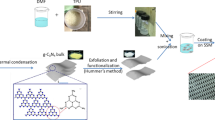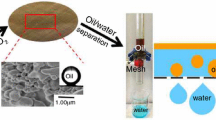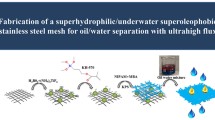Abstract
In this work, multi-component interpolymer complexes (MCIPCs) layer by layer (LBL) hybrid mesh with superhydrophilicity and underwater superoleophobicity (SHSO) characteristic was produced by coating poly(acrylic acid) (PAA), poly(vinyl alcohol) (PVA), graphene oxide (GO), and sodium alginate (SA) on the surface of oxidized stainless-steel mesh (OSSM). The surface roughness of the as-prepared MCIPCs-GO LBL hybrid mesh (LHM) increased in comparison with raw OSSM, and its SHSO behavior enhanced significantly, which in turn, resulted in an improved wettability. The prepared membranes were characterized by scanning electron microscopy (SEM), energy-dispersive X-ray spectroscopy (EDS, map**), and X-ray diffraction (XRD). In addition, the SHSO characteristics were estimated by contact angle meter. Moreover, the role of PAA, PVA, SA, and GO on the roughness, underwater oil contact angle (UOCA), and water contact angle (WCA) was fully investigated. Furthermore, the optimized MCIPCs-GO LHM was used for separation of some ideal and real (processed crude) oils from water. The LHM showed a high separation efficiency (ɳ > 99.55%) for real emulsion and water flux of ∼ 168000 ± 95 L m−2 h−1. Moreover, due to the excellent chemical/mechanical stability, noteworthy performance, and brilliant reusability, the membrane seems to be promising renewable material for treatment of oily waters and marine oil leakages.
Graphical Abstract











Similar content being viewed by others
Reference
Mendelssohn IA, Andersen GL, Baltz DM, Caffey RH, Carman KR, Fleeger JW, Joye SB, Lin Q, Maltby E, Overton EB (2012) Oil impacts on coastal wetlands: implications for the Mississippi River Delta ecosystem after the Deepwater Horizon oil spill. Bioscience 62(6):562–574
Ainsworth CH, Paris CB, Perlin N, Dornberger LN, Patterson WF III, Chancellor E, Murawski S, Hollander D, Daly K, Romero IC (2018) Impacts of the Deepwater Horizon oil spill evaluated using an end-to-end ecosystem model. PloS one 13(1):e0190840
Zhong Q, Shi G, Sun Q, Mu P, Li J (2021) Robust PVA-GO-TiO2 composite membrane for efficient separation oil-in-water emulsions with stable high flux. J Membr Sci 640:119836
Gill DA, Picou JS, Ritchie LA (2012) The Exxon Valdez and BP oil spills: A comparison of initial social and psychological impacts. Am Behav Sci 56(1):3–23
Incardona JP, Swarts TL, Edmunds RC, Linbo TL, Aquilina-Beck A, Sloan CA, Gardner LD, Block BA, Scholz NL (2013) Exxon Valdez to Deepwater Horizon: comparable toxicity of both crude oils to fish early life stages. Aquat Toxicol 142:303–316
Nikzad E, Sabzevari MH, Ghaedi M, Azqhandi MA, Marahel F (2022) Graphene oxide/double-layer hydroxide hybrids for efficient crude oil-water separation. Mater Chem Phys 281:125917
Chu Z, Feng Y, Seeger S (2015) Oil/water separation with selective superantiwetting/superwetting surface materials. Angew Chem Int Ed 54(8):2328–2338
Zhou H, Wang H, Lin T, Niu H (2022) A novel Janus fabric with stable amphibious directional oil transport function. Chem Eng J 427:131936
Cui J, **e A, Liu Y, Xue C, Pan J (2021) Fabrication of multi-functional imprinted composite membrane for selective tetracycline and oil-in-water emulsion separation. Compos Commun 28:100985
**ang B, Sun Q, Zhong Q, Mu P, Li J (2022) Current research situation and future prospect of superwetting smart oil/water separation materials. J Mater Chem A 10(38):20190–20217
Padaki M, Murali RS, Abdullah MS, Misdan N, Moslehyani A, Kassim M, Hilal N, Ismail A (2015) Membrane technology enhancement in oil–water separation. A review. Desalination 357:197–207
**e A, Wu Y, Liu Y, Xue C, Ding G, Cheng G, Cui J, Pan J (2022) Robust antifouling NH2-MIL-88B coated quartz fibrous membrane for efficient gravity-driven oil-water emulsion separation. J Membr Sci 644:120093
**e A, Cui J, Liu Y, Xue C, Wang Y, Dai J (2021) Preparation of Janus membrane based on biomimetic polydopamine interface regulation and superhydrophobic attapulgite spraying for on-demand oil-water emulsion separation. J Membr Sci 627:119242
Wu M, **ang B, Mu P, Li J (2022) Janus nanofibrous membrane with special micro-nanostructure for highly efficient separation of oil–water emulsion. Sep Purif Technol 297:121532
Zhou W, Fang Y, Li P, Yan L, Fan X, Wang Z, Zhang W, Liu H (2019) Ampholytic chitosan/alginate composite nanofibrous membranes with super anti-crude oil-fouling behavior and multifunctional oil/water separation properties. ACS Sustain Chem Eng 7(18):15463–15470
Cui J, **e A, Yan Z, Yan Y (2021) Fabrication of crosslinking modified PVDF/GO membrane with acid, alkali and salt resistance for efficient oil-water emulsion separation. Sep Purif Technol 265:118528
**e A, Cui J, Yang J, Li C, Wang Y, Dai J (2021) Active antifouling carbon cloth@ Ni-Co LDH/Ag membrane for efficient oil/water separation. Appl Clay Sci 211:106161
Babiker DM, Zhu L, Yagoub H, Xu X, Zhang X, Shibraen MH, Yang S (2019) Hydrogen-bonded methylcellulose/poly (acrylic acid) complex membrane for oil-water separation. Surf Coat Technol 367:49–57
Vasheghani Farahani B, Hosseinpour Rajabi F, Ahmadi MH, Zenooz N (2012) Qualitative investigation on some H-bonded interpolymer complexes by determination of thermodynamic parameters. J Mex Chem Soc 56(2):212–216
Vasheghani F, Rajabi B, Ahmadi FH, Zenooz MH (2011) Effect of various types of interaction on the stability of some ternary interpolymer complexes involving poly (ethylene imine), poly (acrylic acid) and poly (ethylene glycol). Polym Int 60(2):279–283
Peng Y, Wen G, Gou X, Guo Z (2018) Bioinspired fish-scale-like stainless steel surfaces with robust underwater anti-crude-oil-fouling and self-cleaning properties. Sep Purif Technol 202:111–118
Dai J, Wang L, Wang Y, Tian S, Tian X, **e A, Zhang R, Yan Y, Pan J (2020) Robust nacrelike graphene oxide–calcium carbonate hybrid mesh with underwater superoleophobic property for highly efficient oil/water separation. ACS Appl Mater Interfaces 12(4):4482–4493
Vasheghani F, Rajabi B, Ahmadi F (2007) Influence of solvent on thermodynamic parameters and stability of some multicomponent polymer complexes involving an acrylic polymer, poly (ethylene imine) and poly (vinyl pyrrolidone). Polym Bull 58(3):553–563
Vasheghani F, Rajabi B, Ahmadi F, Mashhadi M (2008) Investigation on thermodynamic parameters and stability of some polyelectrolyte complexes with respect to ionic strength of the medium. Polym Bull 61(2):247–255
Vasheghani F, Rajabi B, Ahmadi F, Nouhi M (2006) Stability and thermodynamic parameters of some selective intermacromolecular complexation. Polym Bull 56(4):395–404
Vasheghani F, Rajabi B, Ahmadi F, Nouhi M (2005) Stability constants and thermodynamic parameters of some intermacromolecular complexes in relation to their specific interaction forces. Polym Bull 55(6):437–445
Rajabi F, Ahmadi M (2007) Influence of solvent on thermodynamic parameters and stability of some multicomponent polymer complexes involving an acrylic polymer, poly (ethylene imine) and poly (vinyl pyrrolidone). Polym Bull 58(3):553–563
Rajabi F, Ahmadi M, Mashhadi F (2008) Investigation on thermodynamic parameters and stability of some polyelectrolyte complexes with respect to ionic strength of the medium. Polym Bull 61(2):247
Rajabi F, Ahmadi M, Nouhi S (2005) Stability constants and thermodynamic parameters of some intermacromolecular complexes in relation to their specific interaction forces. Polym Bull 55(6):437–445
Rajabi F, Ahmadi M, Nouhi S (2006) Stability and thermodynamic parameters of some selective intermacromolecular complexation. Polym Bull 56(4–5):395–404
Vasheghani Farahani B, Rajabi F, Ahmadi M, Gholehzadeh A (2009) Effect of ionic strength of the solution of some hydrogen-bonded interpolymer complexes on the stability and thermodynamic parameters. Polimery 54(4):261
Prasannan A, Udomsin J, Tsai H-C, Sivakumar M, Hu C-C, Wang C-F, Hung W-S, Lai J-Y (2020) Special wettable underwater superoleophobic material for effective simultaneous removal of high viscous insoluble oils and soluble dyes from wastewater. J Membr Sci 603:118026
Kaplan M, Kasgoz H (2011) Hydrogel nanocomposite sorbents for removal of basic dyes. Polym Bull 67(7):1153–1168
Wang L, Zhang J, Wang A (2011) Fast removal of methylene blue from aqueous solution by adsorption onto chitosan-g-poly (acrylic acid)/attapulgite composite. Desalination 266(1–3):33–39
Foroughi M, Azqhandi MHA (2020) A biological-based adsorbent for a non-biodegradable pollutant: Modeling and optimization of Pb (II) remediation using GO-CS-Fe3O4-EDTA nanocomposite. J Mol Liq 318:114077
Noorani-Khamirajni F, Azqhandi MA, Ghalami-Choobar B (2021) Rapid and efficient ultrasonic assisted adsorption of PNP onto LDH-GO-CNTs: ANFIS, GRNN and RSM modelling, optimization, isotherm, kinetic, thermodynamic and mechanism study. J Mol Liq 333:115917
Zhao X, Su Y, Liu Y, Li Y, Jiang Z (2016) Free-standing graphene oxide-palygorskite nanohybrid membrane for oil/water separation. ACS Appl Mater Interfaces 8(12):8247–8256
Liu P, Zhang Y, Liu S, Zhang Y, Qu L (2019) Fabrication of superhydrophobic marigold shape LDH films on stainless steel meshes via in-situ growth for enhanced anti-corrosion and high efficiency oil-water separation. Appl Clay Sci 182:105292
Khomeyrani SFN, Azqhandi MHA, Ghalami-Choobar B (2021) Rapid and efficient ultrasonic assisted adsorption of PNP onto LDH-GO-CNTs: ANFIS, GRNN and RSM modeling, optimization, isotherm, kinetic, and thermodynamic study. J Mol Liq 333:115917
Radmehr S, Sabzevari MH, Ghaedi M, Azqhandi MHA, Marahel F (2021) Adsorption of nalidixic acid antibiotic using a renewable adsorbent based on Graphene oxide from simulated wastewater. J Environ Chem Eng 9(5):105975
Yang J, Zhang Z, Xu X, Zhu X, Men X, Zhou X (2012) Superhydrophilic–superoleophobic coatings. J Mater Chem 22(7):2834–2837
You Q, Ran G, Wang C, Zhao Y, Song Q (2018) Facile fabrication of superhydrophilic and underwater superoleophobic chitosan–polyvinyl alcohol-TiO 2 coated copper mesh for efficient oil/water separation. J Coat Technol Res 15(5):1013–1023
Igder A, Rahmani AA, Fazlavi A, Ahmadi MH, Ahmadi Azqhandi MH, Omidi MH (2012) Box-Behnken Design of Experiments Investigation forAdsorption of Cd2 + onto carboxymethyl Chitosan Magnetic Nanoparticles. J Min Environ 3(1):51–59
You Q, Ran G, Wang C, Zhao Y, Song Q (2018) Facile fabrication of superhydrophilic and underwater superoleophobic chitosan–polyvinyl alcohol-TiO2 coated copper mesh for efficient oil/water separation. J Coat Technol Res 15(5):1013–1023
Cheng Q, Jiang L, Tang Z (2014) Bioinspired layered materials with superior mechanical performance. Acc Chem Res 47(4):1256–1266
Acknowledgments
The authors express their appreciation of Yasouj University for supporting this work.
Funding
The authors have not disclosed any funding.
Author information
Authors and Affiliations
Contributions
M. H. Ahmadi Azqhandi: writing-review and editing, original draft, methodology, visualization, investigation, conceptualization. Omid Jashnsaz: original draft, visualization, Investigation. Mina Hosseini: original draft, methodology, visualization, investigation, conceptualization. Mina Hosseini: original draft, methodology, visualization, investigation, conceptualization. Bahram Soltani Soulgani: original draft, methodology, visualization, investigation, conceptualization.
Corresponding authors
Ethics declarations
Conflict of interest
The authors declare that they have no known competing financial interests or personal relationships that could have appeared to influence the work reported in this paper.
Additional information
Publisher’s Note
Springer Nature remains neutral with regard to jurisdictional claims in published maps and institutional affiliations.
Supplementary Information
Below is the link to the electronic supplementary material.
Rights and permissions
Springer Nature or its licensor (e.g. a society or other partner) holds exclusive rights to this article under a publishing agreement with the author(s) or other rightsholder(s); author self-archiving of the accepted manuscript version of this article is solely governed by the terms of such publishing agreement and applicable law.
About this article
Cite this article
Jashnsaz, O., Sabzevari, M.H., Ghaedi, M. et al. Synthesis and Characterization of a New Bioinspired Superhydrophilic/Underwater Superoleophobic Hybrid Mesh Based Multi-Component Interpolymer Complexes: Exceptional Mechanical/Chemical Stability and Reusability. J Polym Environ 31, 3480–3492 (2023). https://doi.org/10.1007/s10924-023-02795-0
Accepted:
Published:
Issue Date:
DOI: https://doi.org/10.1007/s10924-023-02795-0




